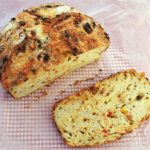
Picnic Bread
Ingredients
- 600 g bread flour plus extra for dusting
- 1.5 tsp salt
- Half a large yellow pepper, cut into small dice & roasted in olive oil until just soft use jarred roasted peppers if liked
- Half a large red pepper, cut into small dice & roasted in olive oil until just soft use jarred roasted peppers if liked
- 1 medium onion, chopped & roasted in olive oil until just soft
- 2 cloves garlic, finely chopped & roasted with the onions above
- 4-6 sun-dried tomatoes in oil, drained
- 4-6 slices salami cut into small squares
- 120 g cheese e.g. Cheddar, gruyere or a mixture grated
- 30 g Parmesan cheese finely grated
- Handful basil leaves shredded
Using fast-acting yeast
- 7 g quick, fast-acting dried yeast
- 460 ml water
Using sourdough starter
- 60 ml sourdough starter lively, refreshed approx 6 hours before
- 400 ml water
Instructions
THE NIGHT BEFORE YOU WANT TO BAKE THE BREAD:
-
Using fast-acting yeast:
Put the flour, salt and dried yeast in a large mixing bowl and gradually stir in all the water.
Using sourdough starter:Put the flour and salt in a large mixing bowl.
Dissolve the starter in the water and gradually stir it all into the flour and salt.
-
Use a rubber spoon or spatula to bring the mixture together into a rough, wet dough.
Cover with cling film and leave overnight or 12-14 hours.
ON THE DAY OF BAKING:
-
Scrape the dough out of its bowl onto a well-floured worktop and flatten out.
-
Scatter half the roasted vegetables, tomatoes, cheese (keep back a little of the Parmesan for sprinkling), salami and basil over the dough. Fold over the sides of the dough to cover the mix and flatten the dough again.
-
Scatter the rest of the filling over the dough, fold over the sides again and continue folding until the filling is incorporated throughout. You might need to flour the dough and your work surface several times to stop it sticking.
-
Form the dough into the approximate shape of a proving basket or tea-towel lined bowl. Cover and leave to rest while you dust the basket or tea-towel with plenty of flour to prevent sticking.
-
Flip the dough into the proving basket or bowl, cover with cling film or a tea towel and leave to rest: 30 minutes for dough with fast-acting yeast, 60-90 minutes for sourdough.
-
Pre-heat your oven to 250C, or its highest setting, with a heavy, lidded pot inside to heat up also.
-
When the proving time is up, reduce oven temperature to 220C, remove the pot from the oven, take off the lid and carefully flip the dough from the proving vessel into the pot.
-
Sprinkle the top of the dough with the reserved Parmesan, then slash the dough, replace the lid and put the pot back in the oven. Leave to bake for 30 minutes without removing the lid.
-
After 30 minutes, reduce the heat to 200C. Remove the pot from the oven, take the bread out of it (you may need to run a knife around the inside of the pot to loosen the bread) then put the bread back in, directly onto the oven shelf.
-
Bake for a further 15-20 minutes until the bread is cooked through. If necessary, reduce the oven temperature to stop the crust overbrowning before the loaf is finished baking.
-
When done, cool on a wire rack for a while. Either serve slightly warm or leave until completely cold before taking on your picnic, storing or freezing.